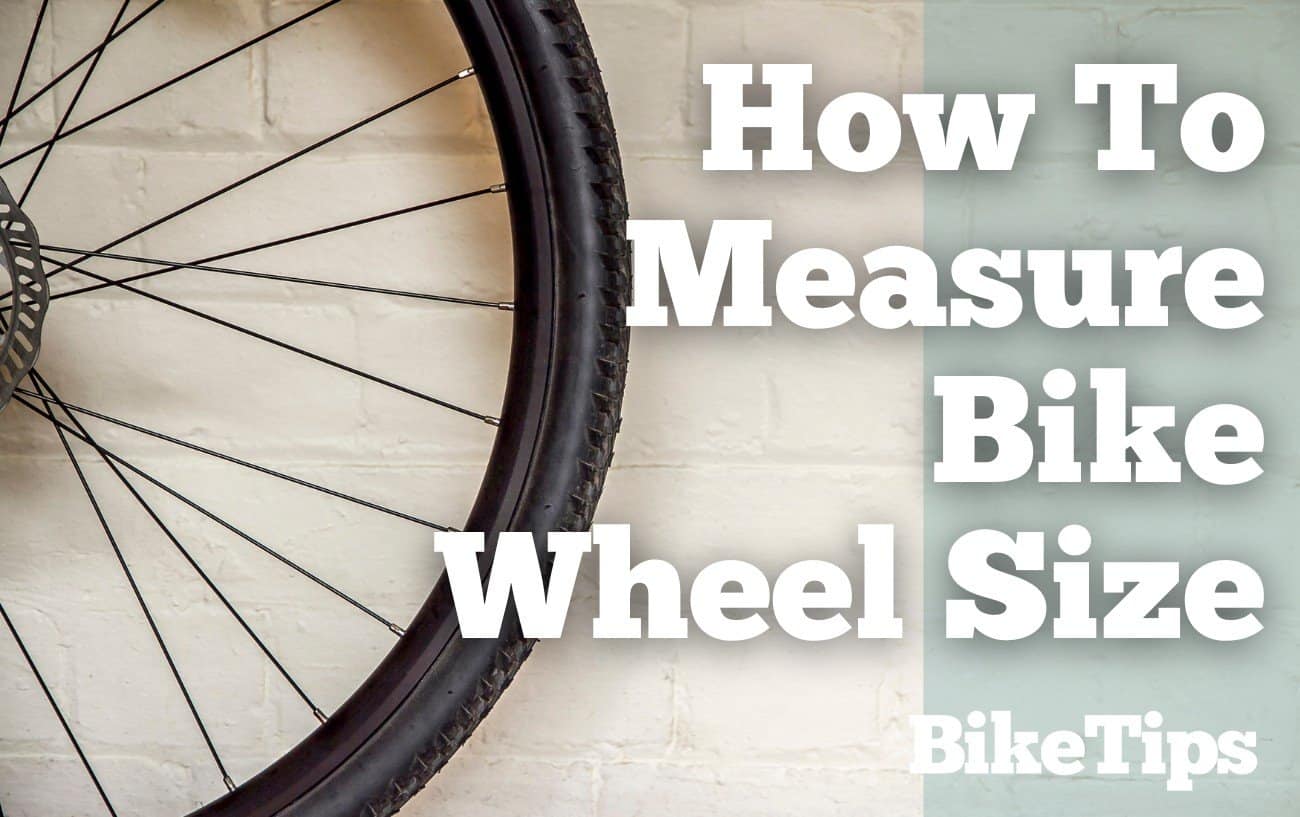There are bikes of all shapes and sizes, designed for different purposes and preferences of riders. One of the most noticeable differences when you look into bike specifications is their wheel sizes.
When you are in the market for a new bike, paying attention to the wheel size is essential, as it affects how the bike handles and performs. Therefore, you should know how to measure bike wheel size to help you make an informed decision.
In this article, we’ll be covering:
- The Different Bike Wheel Size Standards
- The Most Common Bike Wheel Sizes
- How To Measure Bike Wheel Size
Ready for the lowdown on how to measure bike wheel size?
Let’s get started.

The Different Bike Wheel Size Standards
When you look at bike wheel sizes, you might notice a few different ways they’re indicated.
For example, a 29″ wheel may be labeled as 29″, 700C, or ISO 622mm.
This can be confusing if you’re new to bikes, but it’s not as complicated as it may first appear. The primary bike wheel size standards you need to know are:
International Organization for Standardization (ISO)
The International Organization for Standardization (ISO) evolved with the European Tyre and Rim Technical Organization (ETRTO). It’s the most commonly used bike wheel size system today.
A bike wheel labeled using the ISO standard is sized by the wheel’s diameter, not the external measurement of the tire.
European Tyre and Rim Technical Organization (ETRTO)
Together with ISO, ETRTO sets standards for wheel and tire sizing across countries and manufacturers.
The reason for this is that we don’t have the problem of localized wheel and tire sizing systems, which would create confusion by referring to the same size by multiple names.
French Standard
The French wheel size standard is mainly used when talking about vintage bikes.
The letters in the French standard refer to the wheels’ widths. For instance, a 700C tire is wider than a 700B tire.
American Standard
The American standard simply states the wheel sizes in inches and is the most common notation used in the U.S.

The Most Common Bike Wheel Sizes
16″ Wheels (ISO 305 mm)
Most 16″ wheels are used on kid’s bikes, but they’re also the smallest wheels found on adult bikes. Bike manufacturers will put 16″ wheels on folding bikes to make them more compact.
The disadvantage of wheels this small is that they compromise ride quality, as they don’t roll over bumps too well. They give the bike a tight turning radius, but its steering becomes very sensitive.
Small wheels need larger gear ratios to allow the bike to keep up with bikes with larger wheels. Therefore, riding uphill becomes harder work.
16″ wheels are great for kids learning to maneuver the bike and stay upright.
20″ Wheels (ISO 406 mm)
Most BMX bikes have 20″ wheels as they make the bike maneuverable, which is important for tricks. However, the fact that they are not much bigger than 16″ wheels means that they suffer from similar drawbacks, but to a lesser extent.
20″ wheels are affected by bumps and obstacles more than larger wheels. The bikes also require suitable geometry to provide a comfortable, upright riding position.
At this point, it is worth mentioning that there is a slightly larger wheel size that is also referred to as 20″, but is not the same as ISO 406. This larger wheel, ISO 451, is often used on racing BMX bikes and some classic commuter bikes.
ISO 451 is pretty rare these days, so most people talking about 20″ rims are referring to ISO 406.
24″ Wheels (ISO 507 mm)
You may come across bikes with 24″ wheels, but these are pretty rare. They’ll be on BMX cruisers or junior mountain bikes if you do find them.
BMX cruisers have similar geometry figures and maneuverability to 20″ wheeled bikes but are better for larger riders.
Youth mountain bikes with 24″ wheels typically have higher specifications than ones with smaller wheels, making them ideal for racers to progress.
26″ Wheels (ISO 559 mm)
26″ has been a standard bike wheel size for many years. These wheels used to be the most popular mountain bike wheels size due to their strength, maneuverability, and fast acceleration.
The term “26 inch” refers to the tire’s outer diameter. The actual ISO diameter of a traditional 26″ wheel is 559mm.
Even though these smaller wheels provide fun and agile handling, they don’t roll as fast as larger sizes. Therefore, 26″ wheels are pretty much phased out in the mountain bike world.
This is worth remembering if you’re about to buy a used mountain bike with 26″ wheels, as good tires are becoming harder to find.
27.5″ / 650b Wheels (ISO 584 mm)
27.5″ wheels are also known as ISO 584mm, and 650b. This is an old touring bike wheel size introduced in the 1960s and is slightly smaller than modern road bike wheels.
The size was initially used for bike frames too small for 700c wheels, but 27.5″ wheels were adopted for use on mountain bikes. Some mountain bikers see 27.5″ wheels as the sweet spot between 26″ and 29″ wheels.
27.5″ wheels can roll over bumps easier than smaller wheels while having a larger contact patch with the ground for better traction and braking. They also have a greater rotational momentum to help you maintain momentum while still providing agile handling.
29″ / 700c (ISO 622 mm)
29″ wheels have been on road bikes for many years and have an ISO diameter of 622mm. The term 700c is historical and comes from international tire sizes, where the outer diameter was 700mm.
We mentioned earlier that the “c” refers to the wheel’s width and is the only size that remains in popular use after sizes “a” and “b” died out. The 622mm wheel size became the most common on road bikes.
This larger wheel gives you faster speed and better ride quality than smaller wheels. Therefore, mountain bike manufacturers have started using it on their bikes, with lots of success.
In the mountain bike world, this size is referred to as 29″, and it gives the rider a faster straight-line speed than 27.5″ wheels. However, the larger size increases the bike’s turning radius and makes it less maneuverable. It also takes a little more effort to get up to speed.

How To Measure Bike Wheel Size
If you think you know what bike wheel size you would prefer or need to buy a new tire, you need to know how to measure bike wheel size.
The size should be printed on the tire, but it’s worth learning one of the three ways how to measure bike wheel size.
How To Measure Bike Wheel Size Using The Standard Method
- Prop your bike against a wall, or mount it on a bike stand. This will allow you to accurately measure your bike’s wheels without it falling over.
- Measure from the ground to the wheel’s axle in inches. This will give you the wheel’s radius, which is half of its diameter. It’s best to use a retractable tape measure so you have a free hand.
Multiply your measurement by 2 for the wheel’s diameter.
- Now you have the diameter, you should determine the wheel’s width. All you need to do is run your tape measure across the tire for this measurement.
How To Measure Bike Wheel Size Using The ISO Method
As mentioned earlier, the ISO system uses millimeters to indicate a bike’s wheel size. The smaller increments mean that you get a more accurate measurement this way.
Prop your bike up against a wall, or make sure it is secure enough not to fall on you while measuring. Use the same method as before, but use millimeters rather than inches. You should also measure from the axle to the tire’s inner edge, instead of to the ground.
Then multiply the measurement by 2 to get the diameter.
Calculating the Circumference of a Bicycle Wheel
You may want to fit or calibrate a speedometer or bike computer to record your rides accurately. To do so, you’ll need to measure the circumference of your bike’s wheel. Here’s how to do it:
- Measure the diameter of your wheel using the Standard Method.
- Multiply it by pi (3.14) to get the circumference.
For example, if you have a 26″ wheel your equation will be 26 X 3.14, giving you a circumference of 81.64″.

Now You Know How To Measure Bike Wheel Size…
Learning how to measure bike wheel size isn’t difficult.
Once you get to grip with the different sizes, you’ll probably be able to tell how big a wheel is at a glance. But, if you are in the early stages of learning about bikes, knowing how to measure bike wheel size is a handy skill to have.



